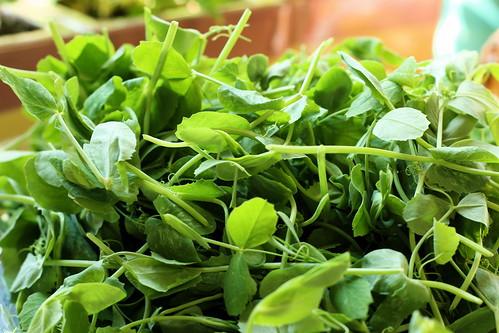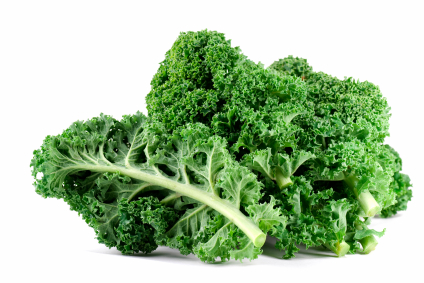I never ate much in the way of "greens" growing up, with the exception of the occasional dandelion greens or fiddle-heads that my friend's family would gather. I've always been much more familiar with the peas, beans, lettuce, brussels sprouts, broccoli side of the spectrum. So the fact that I've had kale, mustard greens, chard, chinese cabbage, kohlrabi, pea tendrils, and "saute greens" in my CSA share are all kind exciting, as they've been new to me.
Pea Tendrils
 |
| Thank you google image for giving me a link to a picture of pea tendrils. The original site this came from was http://veganyumyum.com/2007/05/pea-tendril-and-daikon-noodle-salad/ which, amusingly enough, also seems to be from Boston. |
These are the tips of the pea plant. They taste like peapods, and can be eaten in a lot of different ways. The second week of my CSA I put them into a salad with some lettuce, spring onions, fresh strawberries, and Hannah Bells cheese. All the ingredients came from that week's CSA, except for the blueberry balsamic vinegar and olive oil I used to dress it. It was an absolutely amazing salad. They're super tasty when sauteed, and worked equally well in a risotto with chicken, sage, mushrooms, onion, garlic, and Parmesan cheese.
Greens
I may be sticking my foot in my mouth here, but I'm going to lump kale, chard, and the mixed "saute greens" all together. I'm sure that, with more exposure, I will come to learn that this is blasphemous, and that they should all be appreciated on their own merits. But for now, I will admit to being a greens racist. They all look alike to me.
For anyone who has had the same exposure to greens that I did up until a few weeks ago, there's no reason to be skeptical towards something that looks like a kind of lettuce that you have to cook. My first attempt at making kale was this recipe from the Food Network site. The one change that I made, though, was to add bacon, and use that grease instead of the olive oil. It was fast, easy, and super tasty. I've done the same thing with some of the mustard greens that I've received as well.
Cabbage and Radish and Slaw, Oh My!
The week that I got the kohlrabi and the chinese cabbage (along with some other greens of whose genealogy I was unaware) I was fairly busy, and not home a good chunk of the week. Wanting to make sure that nothing was wasted, I thought of doing a slaw as a way of preserving things for a little longer.
Whenever possible, I like to try to give links to where my ideas come from. I figure that it is only fair. In this case, I have to admit that I have no idea where to find the recipe for the dressing that I used. I've looked. It included mayonnaise, rice wine vinegar, sesame oil (including a little chili sesame oil), ginger, and probably a few other things. For the veggies, I took all of the less delicate greens (mustard greens, chinese cabbage, anything that wasn't lettuce or pea tendrils essentially), washed them thoroughly, and tore them into reasonably small pieces.
Tear? Why didn't I just use a knife, or a mandolin, or one of they many other cutting implements that I have in my kitchen? Because I wasn't going to be eating it right away. Some say that when you cut lettuce with a knife, the metal in the knife will react with the lettuce, causing it to brown. This is not true. This episode of Good Eats goes into it in detail. Think of lettuce like a piece of bubble wrap. If you cut the bubble wrap with scissors, then any bubbles in the way will get popped. If you tear it, the tear will often follow the path of least resistance, and rip along the thinner plastic where the bubbles are not. In lettuce, the "bubbles" are the cells that have the chemicals that will cause lettuce to brown. So by tearing it, the pieces are not as evenly sized, but the cells do not get as damaged, and don't brown as fast. Of course, as I was using thicker, more robust greens, they probably could have stood up to a knife without too many ill effects. So, in this case, there probably was no reason to do so, other than the fun of ripping things up with my hands (and to educate you against your will on the cellular mechanics of edible plants) .
I peeled and sliced the kohlrabi, and sliced the spring onions to throw in. All of the descriptions of kohlrabi I found describe it as being similar to a radish. I find that is not true, but maybe this is because I grew up in broccoli country. If you ever eat the raw stems of broccoli, the flavor of kohlrabi is kind of like that, but a little crunchier. I tossed it all with the dressing, and then let it sit to let the flavors meld. What I ended up with was slightly spicy, slightly crunchy, and had a much more varied flavor profile than what I had figured. Because all the greens looked very similar going in, and looked the same in the slaw, I never knew quite what I was going to get with each bite.


No comments:
Post a Comment